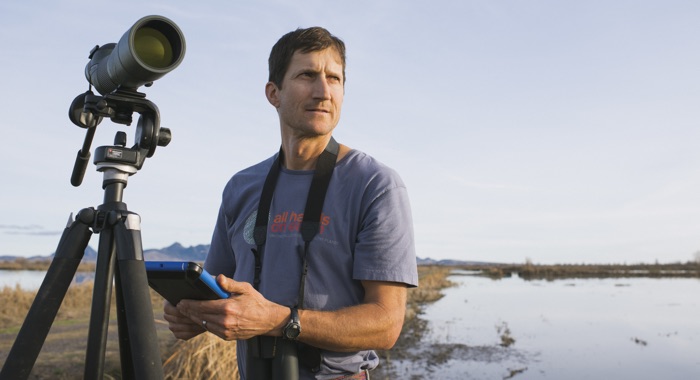California is the leading agricultural state in the country and it’s agriculture generates more than $45 billion annually. About 10 million acres of the state is intensively cultivated land, using roughly 80 percent of the developed water supply. Only a small fraction of these lands are managed deliberately in ways that minimize impacts to nature and maximize the services that nature can provide back to the farm. This has come at a substantial price to nature and the future resilience of agriculture.
Maintaining a mix of natural areas along farm fields and along waterways can provide vital habitat and movement corridors for wildlife, as well as important services like pollination and pest control from native insects, erosion control, and improved water quality. Sustainable management of soils and crops themselves can further reduce the ecological footprint of the land use, and indeed provide habitat for some native species.
Conservancy scientists are investigating these co-benefits, to inform how policy and market incentives could promote food production practices that sustain nature as well as people.


Erin. E. Conlisk, Gregory H. Golet, Mark D. Reynolds, Nathan Elliot. and Matthew E. Reiter
Shorebirds are the second fastest declining group of birds in North America. To reverse this trend, The Nature Conservancy has been implementing BirdReturns, a habitat incentive program that pays…Kristen E. Dybala, Kristin. A. Sesser, Matthew E. Reiter, W. David Shuford, Gregory. H. Golet, Catherine Hickey, and Thomas Gardali
Conserving birds is a key goal for management of the Sacramento–San Joaquin Delta ecosystem, one of the largest estuaries on the Pacific Coast, and is likely to have effects for populations well…Benjamin P. Bryant, Tessa Maurer, Phillip C. Saksa, John D. Herman, Kristen N. Wilson, Edward Smith
The authors of this study analyzed how wildfires and forest restoration, specifically thinning and prescribed fire being implemented in the French Meadows Project in the central Sierra Nevada, could…Grace C. Wu, Ryan A. Jones, Emily Leslie, James H. Williams, Andrew Pascale, Erica Brand, Sophie Parker, Brian Cohen, Joseph Fargione, Julia Souder, Maya Batres, Mary G. Gleason, Michael H. Schindel, Charlotte K. Stanley
This paper presents the results of the Power of Place-West project. The authors combined energy modeling with ecosystem and wildlife habitat data to determine the costs and impacts associated with…Erin E. Conlisk, Kristin B. Byrd, Elliot Matchett, Austin A. Lorenz, Michael Casazza, Gregory H. Golet, Mark D. Reynolds, Kristin A. Sesser, and Matthew E. Reiter
Landscape-scale wetland conservation requires understanding how wildlife responds to dynamic freshwater habitat availability. This study examined this for dabbling ducks by comparing habitat…Charles J. Maxwell, Robert M. Scheller, Kristen N. Wilson, Patricia N. Manley
The authors hypothesized that mimicking the historic fire-return interval, by matching it with the combined frequency of natural disturbances (wildfire) and management (i.e., thinning and…Gregory. H. Golet, Kristen. E. Dybala, Matthew. E. Reiter, Kristin. A. Sesser, Mark Reynolds, Rodd Kelsey
Shorebirds have declined precipitously in North America in the last 50 years, primarily due to the loss of wetlands. Incentive programs that pay farmers to create temporary wetland habitat on idled…Christopher J. Lortie, Maria Florencia Miguel, Alessandro Filazzola, Harry Scott Butterfield
Climate change, drought, and water scarcity are driving major land transformations in dryland ecosystems globally. Historically these ecosystems have been disproportionately degraded due to widespread…Roland Geyer, Jenna Gavigan, Alexis M. Jackson, Vienna R. Saccomanno, Sangwon Suh, Mary G. Gleason
Synthetic microfibers are the most prevalent type of microplastic and apparel washing is a major source of microfiber pollution. Using California as a case study to estimate the magnitude of…Christopher Dillis, Van Butsic, Jennifer Carah, Samuel Zipper, Theodore Grantham
Water management practices for cannabis farming in California are not well understood. This study examined permit reporting data and found that the vast majority (>75%) of permitted cannabis farms…H. Scott Butterfield, T. Rodd Kelsey, and Abigail K. Hart, Editors
As the world population grows, so does the demand for food, putting unprecedented pressure on agricultural lands. At the same time, climate change, soil degradation, and water scarcity mean that…Erin Conlisk, Gregory H. Golet, Mark D. Reynolds, Blake Barbaree, Kristin Sesser, Kristen Byrd, Sam Veloz, Matthew E. Reiter
Highly mobile species, such as migratory birds, respond to seasonal and yearly changes in resource availability by moving among habitats. Understanding how they select among habitats is important for…M. Florencia Miguel, H. Scott Butterfield, Christopher J. Lortie
This meta-analysis provides a global synthesis of the which restoration practices – active vs. passive – are most successful at restoring plants, animals, and other ecosystem functions to…Ethan Inlander, Katie Andrews, Contributors: Jennifer Chin, Sue Pollock, Mike McFadden, Scott Hardage, Scott Butterfield, Tod Rubin
With this publication, TNC in California marks a major shift in its approach to conservation easement monitoring. At the crossroads of conservation, stewardship and technology lies remote property…Benjamin P. Bryant, T R. Kelsey, Adrian L. Vogl, Stacey A. Wolny, Duncan J. MacEwan, Paul C. Selmants, Tanushree Biswas, H S. Butterfield
Irrigated agriculture has grown rapidly over the last 50 years, helping food production keep pace with population growth, but also leading to significant habitat and biodiversity loss globally. Now,…Rodd Kelsey, Scott Butterfield, Abigail Hart, Ruthie Redmond, Hope Bigda-Peyton
This Policy Brief summarizes the results of a study on the potential for strategic habitat restoration in the San Joaquin Valley of California as an important part of reducing overall water…Sara M. Kross, Breanna L. Martinico, Ryan P. Bourbour, Jason M. Townsend, Chris McColl, T. Rodd Kelsey
Agriculture-dominated landscapes harbor significantly diminished biodiversity. Woody vegetation along field margins can provide farmers with ecosystem services and benefit biodiversity. However, when…Christopher J. Lortie, Jenna Braun, Michael Westphal, Taylor Noble, Mario Zuliani, Emmeleia Nix, Nargol Ghazian, Malory Owen, H. Scott Butterfield
This paper evaluates how endangered species with highly restricted habitat needs and increasingly small population sizes (using blunt-nosed leopard lizard as our example), select and use available…